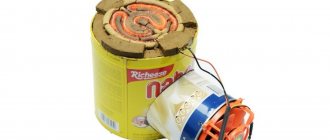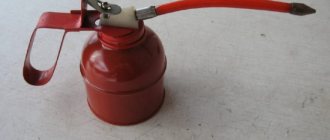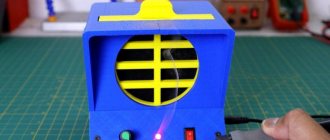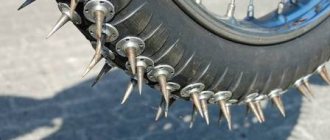Making a kinetic sculpture with your own hands
I’ll say right away that I didn’t come up with this futuristic windmill. The author of this kinetic sculpture (that is, not static, familiar to everyone, but moving) is the German artist Michael Hisscher. “The moving elements are centrally attached to the axes of the work and are so precisely balanced that even the slightest breeze will set them in motion. The gently balanced wings of each sculpture. find their center in weightlessness.
At first I was puzzled by finding suitable bearings. A friend with whom I shared my crazy idea advised me to take them from spinners.
However, he retained his lightest spin. It's a pity that there was only one such trinket available. A study showed that it uses a 608 bearing. The shaft diameter of 8 mm seemed to me quite suitable for the future design. Another pair of bearings of the same size were successfully discovered in the garage. And I decided to make the blades themselves, or wings, as they are called in the original, from a rectangular duralumin pipe with a cross-section of 20x40 mm, purchased on the construction market.
With light blows of a hammer (it is better to use a mandrel), I pressed the bearings of the horizontal axes into the pipe. I first secured the axles themselves in them, which were M8x60 mm bolts. I tightened the nuts tightly, squeezing the inner rings between them and the bolt heads, because if the connection becomes loose, it will be impossible to tighten it without removing the bearing. To install the vertical axis of the hub, use an M8 threaded hole made in the wall in the middle (along the length) of the pipe.
Now it's up to the blades. I cut a piece of rectangular pipe. On one side I attached a stabilizer made of a 1 mm thick duralumin sheet to it. I just made rectangles 160x200 mm, but here you can use your imagination. In the original, for example, there are stabilizers in the form of rings. It seems to me that they can be of any shape, but must be symmetrical so as not to disturb the center of mass of the blade. I used M4 screws to secure the stabilizers to the blades. Both wings are, of course, exactly the same.
The secret of the “sculpture” lies in the fact that due to the installation of a stabilizer on one side of the blade, its axis of rotation shifts towards the heavier part (if we want the blade to maintain an arbitrary position in space, and not always look down with the stabilizer). This is obvious, but such a simple asymmetry looks very funny. And here it is important to find the exact location of this axis. To do this, I clamped the knife handle in a vice and placed the assembled blade on the sharp blade. Shifting it fractions of a millimeter left and right, I determined the equilibrium point and made a hole in it with a diameter of 8 mm for the axis. Even replacing one stabilizer mounting screw can disrupt static balancing. But I didn’t carry out dynamic balancing: it’s not clear how to do it at home, and it’s probably not needed, since the speeds here are low.
Assembly of the windmill is simple. We install a spacer bushing on the vertical axis, screw on a piece of our tube-clip and tighten the connection. We put the blades on the horizontal axes and tighten them with nuts. It’s better if they are cap-shaped: with them the finished product looks more elegant. We fix the duralumin corner with screws on a wooden strip and install it strictly vertically (drive it into the ground), using a plumb line for control. The cross-section of the rail should be such that the blades, standing vertically, can freely describe a circle around it, turning in the wind.
Source
Theo Jansen and his work
Theo Jansen creates so-called “kinetic sculptures” or “automatons”. This means that his sculptures themselves move. "Kinesis" is movement. How? Powered by wind energy. By the way, this Danish artist’s first education was in physics, but his art, it must be admitted, is very complex.
Theo Jansen calls his sculptures “beasts”; these animals are fantastic, reminiscent of the anime post-apocalyptic beast - omu - which we all remember from the film “Nausicaä of the Valley of the Wind”.
By the way, this Miyazaki film is his first poem dedicated almost entirely to the wind. (The Master’s second and last poem about the wind is “The Wind Rises”). But let's return to the Danish artist. A series of his works is called “Beach Animals” or – Strandbeest.
The physicist-artist created his animals to be completely autonomous. They themselves interact with the natural environment as if they had an instinct for self-preservation and the rudiments of reason.
Animals walk in herds along the beach, and this is not a metaphor! They burrow into the sand (by themselves) when the wind is too strong to blow them away. They go into the water to “swim” and come out of it so as not to drown, knowing when to stop when swimming. The animal sculptures are created from hollow tubes and even plastic bottles - all of these are wind accumulators.
Messages 14
1 Topic by zhuki 2019-12-01 17:24:18
Theme: Kinetic sculptures
2 Reply from kimin.ru 2019-12-01 18:17:15
Re: Kinetic sculptures
Has anyone been interested in such mechanisms?
Yes you would, just for fun. typed “Kinetic sculptures” into the search engine. I've dialed it. I looked at all sorts of things. And I found a forum with models, where your examples are there. I won’t give a link to the forum—it’s incorrect. But everything is easy to find. There would be a desire. Good luck.
3 Reply from zhuki 2019-12-01 21:18:20
Re: Kinetic sculptures
I don't want to join any clubs. I just want to try to make one such mechanism. If it’s not difficult, post at least one drawing here from this forum at your discretion.
4 Reply from kvest44 2019-12-01 23:44:52
Re: Kinetic sculptures
5 Reply from zhuki 2019-12-02 00:34:22
Re: Kinetic sculptures
This topic is a little off topic. The watch is seriously different from what interests me.
6 Reply from kimin.ru 2019-12-02 02:14:34
Re: Kinetic sculptures
I don't want to join any clubs. I just want to try to make one such mechanism. If it’s not difficult, post at least one drawing here from this forum at your discretion.
Yes, I'm not going to join either. Yes, I said this as an example. Can be found. The easiest option is https://www.lisaboyer.com/Claytonsite/zinniapage1.htm And if it’s free, then here— https://markswoodchips.com/zinnia-kinet ... ture/.html you can understand how it works from the picture draw vectors in Corel and go ahead. They even gave cutting modes. All in your hands.
7 Reply from zhuki 2019-12-02 11:02:29
Re: Kinetic sculptures
I don't want to join any clubs. I just want to try to make one such mechanism. If it’s not difficult, post at least one drawing here from this forum at your discretion.
Yes, I'm not going to join either. Yes, I said this as an example. Can be found. The easiest option is https://www.lisaboyer.com/Claytonsite/zinniapage1.htm And if it’s free, then here— https://markswoodchips.com/zinnia-kinet ... ture/.html you can understand how it works from the picture draw vectors in Corel and go ahead. They even gave cutting modes. All in your hands.
8 Reply from zhuki 2019-12-02 11:13:02
Re: Kinetic sculptures
9 Reply from kimin.ru 2019-12-02 16:38:38
Re: Kinetic sculptures
In our country there are a dime a dozen such smart people and advisers, but when it comes down to it, it’s all in the bushes.
Dear, there is no need to talk to me in such a tone, dear.
Did I ask for help to give advice on how to do it? I’ll figure out what to draw and how to cut without you.
Well, excuse me, dear. Somehow I didn’t immediately understand that you, dear one, are so advanced. Well, in our country there are a hundred times more such “advanced” people than “smart people and advisers,” dear. Only such “advanced” people don’t have the intelligence to find what they need, dear. Also, there is not enough intelligence (or ability) to make such a model, dear. The only thing “advanced” people are capable of is begging on sites and snatching something “for free”. And when they really want to help them with something, they start to be rude, dear. After this, dear sir, you want help.
Well, here you are right, dear. How many times have I already sworn not to try to help people like you, dear. But. “Don’t do good, you won’t get evil”—the formula works. ALAS. Therefore, I GENERALLY FORGIVE you, dear one, for AT LEAST TRYING TO HELP you, dear one.
Source
What is kinetic art and how does it work?
Architecture is frozen music. This hackneyed expression, attributed to the German philosopher and art theorist Friedrich Schelling, refers to “big” architecture. However, since the middle of the 20th century, artists have increasingly gravitated towards special “small” architectural forms - kinetic sculptures, which can no longer be called frozen. On the contrary, these sculptures, the individual elements of which, interacting, move along bizarre trajectories, fascinate the viewer with constant movement. Art historians write books about kinetic sculptures, and exhibition visitors argue. Together with the Garage Museum of Contemporary Art, we will try to look at them from a different angle—through the eyes of a mathematician.
In 2022, the Garage Museum of Contemporary Art hosted “Transatlantic Alternative,” Russia’s first major exhibition dedicated to the kinetic and optical art of Eastern Europe and Latin America. It exhibited more than a hundred works of art from the 1950s to the 1970s, including kinetic sculptures, paintings, drawings, videos and installations, as well as unique archival materials. A logical continuation of the exhibition “Transatlantic Alternative” was the opening of “Atom” by Vyacheslav Koleichuk - a reconstruction of the monumental color-dynamic sculpture that stood at the origins of kinetic art in Russia. We decided to figure out how “Atom” and other kinetic sculptures work.
Alexander Calder
American sculptor (1898–1976), in the early 1930s turned to the production of dynamic structures - the so-called “mobiles”. Calder's first "mobiles" were driven by motors, but later, striving to create dynamic systems capable of reflecting the constant variability of nature, Calder moved on to "natural" methods of dynamizing form, namely, to structures with unstable equilibrium, capable of moving from the slightest vibration air.
In his works, Calder used mechanisms based on lever scales—structures made of wire and metal rotating under the influence of air currents. It is quite difficult to apply classical mechanics and mathematics to the creation of such “mobiles”, since each of them consists of a large number of parts of completely different shapes. Most likely, the parameters of the sculptures’ elements—flat weights of various shapes arranged hierarchically—were determined experimentally, since Alexander Calder built his first sculpture back in the 1930s. By the way, many art historians believe that he was the first to define the contours of the “mobile” direction of kinetic art.
However, at present, to develop such structures, you can use a computer and the finite element method, when the virtual model is divided into separate very small elements, to which well-known simple physical and mathematical laws and rules are applied - the rule of balance of a lever, the rule of finding the center of gravity of a flat figure and etc. For example, the center of gravity of a ring sector, which appears in Calder's work, is calculated using the following formula:
A frequently recurring motif in Calder is the complex arrangement of “scales” nested within each other. Mobiles built according to this principle have given rise to many imitations, and there are even instructions on the Internet on how to make such a mobile with your own hands, without involving complex calculations:
Theo Jansen
The Dutch artist (born 1948) is known for his “artificial life forms” - skeletal figures that can move along sandy beaches when influenced by the force of the wind. Jansen's genetic algorithms are capable of simulating the biological evolution of species.
In the works of Theo Jansen, the idea of a plantigrade machine is used, the main unit of which converts rotational motion into translational motion. Jansen's sculptures resemble bizarre creatures that deftly move with dozens of legs and move with ease under the influence of the wind. The artist himself calls them “beach animals”, Strandbeest. However, in reality, teaching “animals” to walk without stumbling is not so simple - it is necessary not only to correctly design each leg, but also to organize their joint work. To do this, the sculptor needs to solve a system of nonlinear algebraic equations arising from the Pythagorean theorem.
Here's a concrete example. Let's consider two levers 1 and 2 connected by a hinge at point 5. Let's say we know the coordinates of the ends 3 and 4 and we want to find the position of the hinge. To solve this problem, it is necessary to solve analytically or numerically a system of two nonlinear algebraic equations, where L1 and L2 are the hypotenuses of two right triangles (the lengths of the levers), and x4 − x5, y4 − y5, x3 − y5 and y3 − y5 are the lengths of the legs . As is known, these quantities are connected by the Pythagorean theorem: the square of the hypotenuse is equal to the sum of the squares of the legs.
Of course, each “leg” contains more than two joints, and therefore the task that the artist must solve before building the sculpture is much more difficult. One way or another, it comes down to optimizing the nodes - that is, selecting the lengths of the levers at which the structure will move smoothly, without shocks. Finally, after the sculpture has been designed, optimization strength calculations must be made to ensure that it will not break. This is where the knowledge accumulated by the legendary science called strength of materials (or, as students call it for short, “strength of materials”) comes in handy. And only after all the calculations have been made, the sculptor can take up the tools to assemble a structure from plastic tubes, wooden blocks, tape and polyethylene.
Kinetic wood sculptures, or How to build your dream career
Kinetic sculptures by David Roy are a true symphony of movement. All models “start up” from a light breeze. The parts are skillfully carved from ordinary birch plywood. After removing the sculpture from its equilibrium position, you can observe the changing patterns for 8 to 16 hours. At the same time, the device has neither a motor nor batteries.
"Wooden" hacker
As a child, David loved to watch his father tinker in the garage. It was the parents who instilled in the child a love of manual labor. By the early 1970s, Roy received an engineering degree at Boston University, after which he studied twice more in the departments of chemistry and physics.
During his studies, David often visited his school friend Margie, who was educated at the Rhode Island School of Design. During one of his trips, Margie showed him her creations - several wooden static sculptures that resembled mechanisms. It was these works that gave David the idea: “What if we put all the parts in motion?”
In 1974, David and Margie got married. While Margie continued to study art, David received a position as a computer programmer. He quickly became bored with the monotonous work, and the idea of creating wooden sculptures couldn’t get out of his head... And David began to create.
It all started with models of small children's toys. While Roy coped with the sketches and calculations quickly, his skills as a carpenter did not develop immediately. Margie helped here - due to the nature of her work, she had to work with many materials, including wood.
Here are some of David Roy's first creations:
Having quickly sold original toys at the local market, David realized that by devoting more time to his hobby, he would be able to provide for his family. He left his position as a programmer, devoting himself entirely to his favorite work.
How to make sculptures move?
Having acquired the skills of a carpenter, David wondered how to make things move for a long time? At the same time, he fundamentally did not want to use motors, batteries and wires, because his sculptures had to be completely “natural”.
After several unsuccessful attempts, he developed a mechanism that starts working with a little effort or just a stream of air. Subsequently, the parts set other parts in motion, and so on along the chain.
Not far from David and Margie's home was the Rhinebeck craft market. The largest handmade fair in America was held there twice a year. For two years, David tried to get permission to participate, but the organizers for some unknown reason refused him.
It wasn't until 1977 that Roy managed to put his wooden kinetic sculptures on public display. The works of David and Margie created a sensation among visitors to the exhibition. Within a couple of days they received several hundred orders.
Over time, rumors about exclusive sculptures spread to nearby states, and the flow of orders became stable. This allowed Roy to buy a plot of land, build a house and his own studio workshop on it.
Improving designs
Every year, David's works became more and more unusual, the design became more complex, and, thanks to his own developments, the movement time increased. Here are some of Roy's popular works:
Kaleidoscope (David Roy; 1979)
Serpentine (David Roy; 1979)
Monarch II (David Roy; 2013)
The Movement of the Sun (David Roy; 2014)
Most of David's sculptures can work non-stop for 8 to 16 hours. For several months now he has been working on a model whose parts will rotate for 2 days!
The role of technology in the work of an artist
As an artist trained as an engineer, Roy always stayed abreast of the latest advances and used them in his creativity. When the Apple Macintosh came out in 1984, David bought one immediately.
Whereas before he drew out details on paper, traced patterns on plywood, and then cut out shapes with a handsaw, today, using a Mac in tandem with Adobe Illustrator and LaserWriter, he can accurately draw designs and scale them, then transfer information laser machine to cut out smooth parts.
Adobe After Effects and Strata Design 3D allow him to visualize sculptures in motion before creating them.
To sell his work, David always needed a visual demonstration of sculptures in motion. After all, it is quite difficult to evaluate such beauty from a photo, especially from a text description. A couple of decades ago, Roy shot short videos on camera and then sent them by snail mail to potential clients.
With the advent of the Internet, the process has become much easier. And when YouTube launched in 2005, Roy received another effective and virtually free channel for advertising. Since its inception, videos of David’s sculptures have been viewed more than 5,000,000 times.
Dream career
By remaining open to new ideas and following his creative impulses, David was able to build what he calls his “dream career.”
Roy works in tandem with his wife and does not employ additional employees, although the demand for his sculptures exceeds the studio's capacity. He is an artist, designer, engineer all rolled into one. Margie is mainly involved in promoting their website online. “We switched roles,” says David. “She became a computer nerd and I became an artist.”
Source
Absolute harmony of art with nature: kinetic wind sculptures by Anthony Howe
American artist Anthony Howe creates fantastic kinetic sculptures reminiscent of aliens.
After graduating from the school of painting and sculpting, he painted landscapes in his studio, which was located in a remote mountainous region of New Hampshire.
The five-year idyll ended when, according to Anthony Howe, he became bored with the static images that dominate art in general and his work in particular.
He moved to New York, where he became interested in the idea of creating kinetic sculptures.
Over a 17-year career, he has become the author of unusual designs that live in complete harmony with nature, fit into and decorate the surrounding landscape, move either in a quiet or in a passionate dance under the influence of the wind and sparkle in the rays of the rising or setting sun.
The manufacturing process begins with coming up with an image:
I take long walks and imagine different pictures and shapes.
My favorite moment in my work is discovering a completely new idea, a new movement.
This is followed by the stage of designing 3D models on a computer.
The resulting template is applied to a metal blank, from which a curved configuration is cut out using laser cutting; further processing of the metal is quite traditional.
In addition to stainless metal, Anthony Howe uses polymers, fiberglass, and mirrors to create surreal sculptures.
To test the stability of the structure in strong winds, the inventor uses a funny testing method.
I attach the sculpture to my old Ford F-150 and drive down the freeway.
Kinetic wind sculptures, similar to animated illustrations from science fiction novels, have a mesmerizing effect on the viewer; it is difficult to look away from the enchanting spectacle.
The Design Museum offers a selection of still and animated images from the Anthony Howe collection,
as well as short videos of finely balanced symmetrical and asymmetrical compositions that form a flawless three-dimensional harmony in constant movement.
Write in the comments about your impressions!
Source
Ideas for the garden and cottage
Large gardens can use garden architecture such as gazebos, but small gardens or terraces can also be functional and very cozy.
To achieve the effect
and differentiation of space, a three-dimensional solution is needed. When planning a garden, even a small one, we use a stretcher to support trellises, pergolas, and all those elements that will allow us to create green walls and openwork partitions. Thanks to this procedure, we will break the line of the lawn or decking boards and take the garden to a higher level.
Another important element of any garden is light and decorative elements. It is they, next to the plants, that give an idea of the quality of the space we use. Each person has their own preferences, but beyond that, garden decorations should be coordinated with how we spend our time.










